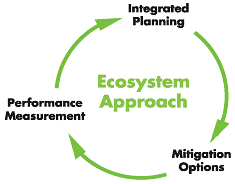















Successes in Stewardship: March 2006 |
|---|

|
Federal Highway Administration
March 2006
Eco-Logical: An Ecosystem Approach to Developing Infrastructure Projects

Over the last several decades, our understanding of how infrastructure can impact habitat and ecosystems has grown. Consequently, awareness of how to better avoid, minimize, and mitigate these impacts has also matured. A new guide has been developed to help agencies form partnerships and translate this awareness into action.
Eco-Logical: An Ecosystem Approach to Developing Infrastructure Projects (Eco-Logical) offers a non-prescriptive approach to making infrastructure more sensitive to wildlife and ecosystems through greater interagency cooperative conservation. It embodies the intent and principles of the National Environmental Policy Act; Executive Order 13352, Facilitation of Cooperative Conservation; and integrated planning concepts developed under Executive Order Environmental Stewardship and Transportation Infrastructure Project Reviews.
This guide was developed by a steering team of representatives from eight Federal agencies and the Departments of Transportation from four States. Eco-Logical articulates a vision of how infrastructure development and ecosystem conservation can be integrated to harmonize economic, environmental, and social needs and objectives. This month's newsletter briefly highlights three key topics in Eco-Logical: the ecosystem approach, integrated planning, and ecosystem-based mitigation.
Central to Eco-Logical is the "ecosystem approach," a method for sustaining or restoring ecological systems and their functions and values. It shifts the Federal government's traditional focus on individual agency jurisdiction to the integrated actions of multiple agencies. The goal-driven ecosystem approach is based on a collaboratively developed vision of desired future conditions that integrates ecological, economic, and social factors. It is applied within a geographic framework defined primarily by ecological, rather than political, boundaries.
Moving beyond the customary project-by-project approach to meeting infrastructure needs and toward the ecosystem approach defined in Eco-Logical can result in a range of benefits, including:

In this map, the most meaningful mitigation for "spot" infrastructure projects (1,2) should occur in the important area of the resource (dark green) and specifically at the areas indicated by the stars. |
Eco-Logical offers the conceptual groundwork for integrated planning, a process by which agencies and their partners:
Identifying these priority areas can help ensure that opportunities to protect them through avoidance, minimization, and — if necessary — mitigation are acted on before critical ecological resources are lost.
Eco-Logical provides a process for the collection, sharing, analysis, and presentation of data in agencies' plans. A key product of this process is a regional ecosystem framework (REF). A REF can help identify ecologically significant areas, potentially impacted resources, regions to avoid, and mitigation opportunities before new projects are initiated. With this understanding, agencies can work together to more accurately identify the areas in most need of protection, better predict and assess cumulative resource impacts, and streamline infrastructure development through increased predictability. Although there is no standard for creating a REF, Eco-Logical recommends that a REF consist of an "overlay" of maps of agencies individual plans, accompanied by descriptions of conservation goals in the defined region.
Beyond a Project-by-Project Approach:
Alabama Protects the Gopher Tortoise
Eco-Logical also supports the consideration of ecosystem-based mitigation where appropriate. Ecosystem-based mitigation is the process of restoring, creating, enhancing, and preserving habitat and other ecosystem features in areas where environmental needs and the potential environmental contributions are greatest. It is implemented in conjunction with, or in advance of, infrastructure projects.
Ecosystem-based mitigation extends existing compensatory mitigation options by offering a way to evaluate alternatives for off-site mitigation and/or out-of-kind mitigation in the ecologically most important areas as defined by interagency partners and the public. It is a potentially enhanced approach to crediting mitigation that builds on existing approaches. Integrating this new concept with lessons learned from previous experience can allow agencies to capitalize on opportunities for substantial habitat connectivity and wildlife conservation while developing needed infrastructure.
Currently, hard copies of Eco-Logical are being published and are expected to be available in spring 2006 through the Federal Highway Administration's (FWHA) Office of Project Development and Environmental Review. The web version is available now at http://www.environment.fhwa.dot.gov/ecological/eco_index.asp.
Carol Adkins
FHWA-HEPE
400 Seventh Street SW
Room 3240
Washington, DC 20590
(202) 366-2054
Carol.Adkins@fhwa.dot.gov
"Successes in Stewardship" is a Federal Highway Administration newsletter highlighting current environmental streamlining and stewardship practices from around the country. To subscribe, visit the Registration Site, or call 617-494-3137. |
